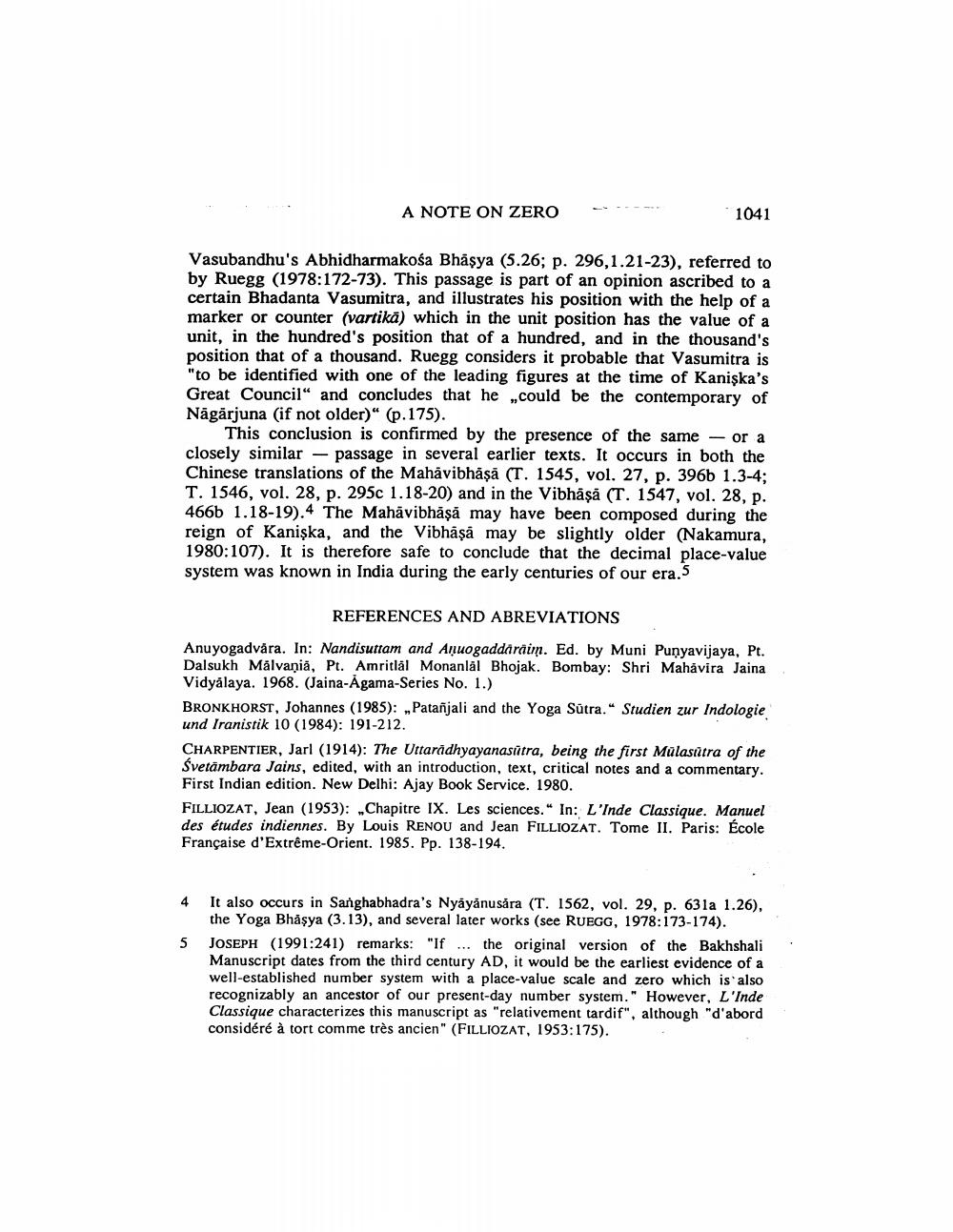Book Title: Note On Zero And Numerical Place Value System In Ancient India Author(s): Johannes Bronkhorst Publisher: Johannes Bronkhorst View full book textPage 3
________________ A NOTE ON ZERO 1041 Vasubandhu's Abhidharmakośa Bhăşya (5.26; p. 296,1.21-23), referred to by Ruegg (1978:172-73). This passage is part of an opinion ascribed to a certain Bhadanta Vasumitra, and illustrates his position with the help of a marker or counter (vartikä) which in the unit position has the value of a unit, in the hundred's position that of a hundred, and in the thousand's position that of a thousand. Ruegg considers it probable that Vasumitra is "to be identified with one of the leading figures at the time of Kaniska's Great Council" and concludes that he could be the contemporary of Nāgärjuna (if not older)" (p. 175). This conclusion is confirmed by the presence of the same - or a closely similar - passage in several earlier texts. It occurs in both the Chinese translations of the Mahāvibhāsā (T. 1545, vol. 27, p. 396b 1.3-4; T. 1546, vol. 28, p. 295c 1.18-20) and in the Vibhasa (T. 1547, vol. 28, p. 466b 1.18-19).4 The Mahavibhāşă may have been composed during the reign of Kaniska, and the Vibhāşă may be slightly older (Nakamura, 1980:107). It is therefore safe to conclude that the decimal place-value system was known in India during the early centuries of our era.5 REFERENCES AND ABREVIATIONS Anuyogadvåra. In: Nandisuttam and Anuogaddaraim. Ed. by Muni Punyavijaya, Pt. Dalsukh Mälvania, Pt. Amritlål Monanlal Bhojak. Bombay: Shri Mahavira Jaina Vidyalaya. 1968. (Jaina-Agama-Series No. 1.) BRONKHORST, Johannes (1985): „Patanjali and the Yoga Sútra.“ Studien zur Indologie und Iranistik 10 (1984): 191-212. CHARPENTIER, Jarl (1914): The Uttarādhyayanasitra, being the first Mülasttra of the Svetämbara Jains, edited, with an introduction, text, critical notes and a commentary. First Indian edition. New Delhi: Ajay Book Service. 1980. FILLIOZAT, Jean (1953): „Chapitre IX. Les sciences." In: L'Inde Classique. Manuel des études indiennes. By Louis RENOU and Jean FILLIOZAT. Tome II. Paris: École Française d'Extrême-Orient. 1985. Pp. 138-194. 4 5 It also occurs in Sanghabhadra's Nyáyānusára (T. 1562, vol. 29, p. 631a 1.26), the Yoga Bhăşya (3.13), and several later works (see RUEGG, 1978:173-174). JOSEPH (1991:241) remarks: "If ... the original version of the Bakhshali Manuscript dates from the third century AD, it would be the earliest evidence of a well-established number system with a place-value scale and zero which is also recognizably an ancestor of our present-day number system." However, L'Inde Classique characterizes this manuscript as "relativement tardif", although "d'abord considéré à tort comme très ancien" (FILLIOZAT, 1953:175).Page Navigation
1 2 3 4
